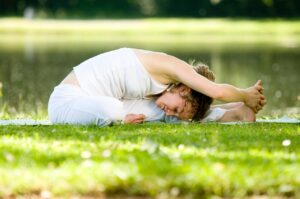
The Importance of Proper Alignment in Yoga Poses

In the world of yoga, alignment is everything. While the external look of a pose might seem important, what matters most is how your body feels and functions in that posture. Proper alignment in yoga poses ensures you’re not only performing each asana safely but also receiving the full physical, mental, and energetic benefits of your practice.
In this article, we explain why correct alignment matters in yoga, how it affects different parts of the body like the knees, hands, spine, and feet, and what role your yoga teacher plays in keeping your posture safe and effective. Ultimately, whether you’re new to yoga or a seasoned yogi, mastering alignment is a game-changer.
Why Proper Alignment in Yoga Matters
In general, yoga is more than just flexibility or strength—it’s about finding the right balance between effort and ease. This is where alignment becomes essential.
Key Benefits of Proper Alignment:
-
Reduces risk of injury
-
Increases muscle engagement
-
Promotes deeper, more effective stretches
-
Enhances breath control and energy flow
-
Supports mental focus and awareness
For that reason, yoga poses done with correct alignment help you go beyond just stretching. They help you tune into your body and use your energy wisely.
Knee Positioning:
Knees are often under pressure during many yoga poses. Although it may seem like a small detail, incorrect knee placement can lead to strain or long-term damage.
For example:
-
In Warrior Poses (Virabhadrasana I & II), the front knee should be directly over the ankle—never extending past the toes.
-
In seated postures or kneeling positions, keep knees aligned with hips and avoid twisting or compressing the joint.
-
In Downward Dog, keep a soft bend in the knees if your hamstrings are tight to avoid pulling on the lower back.
Ultimately, proper knee alignment keeps the joint safe, especially in standing and balancing poses.
Hand Positioning:
Similarly, your hands play a crucial role in weight-bearing yoga poses. Poor hand placement can cause wrist pain and reduce the stability of the posture.
Alignment Tips:
-
In Downward-Facing Dog, spread your fingers wide and press through the knuckles, not just the wrists.
-
In Plank or Chaturanga, align your hands directly under your shoulders for optimal weight distribution.
-
Avoid collapsing the wrists or turning fingers inward, which can strain joints and reduce control.
As a result, you’ll feel more grounded and empowered in arm-supported postures.
Straight Spine:
A neutral spine is the foundation of good posture in yoga. It supports energy flow, encourages proper breathing, and improves focus.
Important Guidelines:
-
In Tadasana (Mountain Pose), stack your head, shoulders, and hips in one line. Engage your core gently.
-
In Seated Forward Folds, avoid rounding your back—hinge at the hips to keep your spine long.
-
In Backbends, focus on evenly distributing the arch through the entire spine rather than collapsing into the lower back.
Therefore, keeping your spine long and neutral in most poses is key to preventing back strain and improving posture.
Feet Positioning:
Your feet are your foundation in many standing poses. Likewise, how you place your feet can affect the alignment of your knees, hips, and spine.
For example:
-
In Warrior Poses, keep your front foot pointing forward and your back foot slightly angled. Distribute your weight evenly.
-
In Tree Pose, place your foot either above or below the knee (never on it) to avoid putting pressure on the joint.
-
In Standing Poses like Tadasana, align your feet hip-width apart and feel all four corners pressing into the ground.
In summary, correct foot positioning helps maintain balance, improves grounding, and protects joints.
The Role of a Yoga Teacher in Guiding Alignment
Even with the best intentions, it’s hard to know if your alignment is right without a trained eye. For that reason, a certified yoga teacher is essential to guide your form.
A skilled teacher will:
-
Offer verbal cues and hands-on adjustments
-
Suggest props (blocks, straps) to support your posture
-
Tailor alignment advice based on your body type, flexibility, and limitations
In the meantime, practicing in front of a mirror or recording yourself can also help you notice misalignments when you’re on your own.
How Alignment Impacts the Body and Mind
When you’re aligned in a pose:
-
Your muscles work efficiently, supporting strength and flexibility.
-
Your joints are protected, reducing wear and tear.
-
Your breath flows more freely, enhancing oxygen intake and focus.
-
Your mind becomes calmer, because the body feels safe and steady.
As a result, alignment isn’t just about physical benefits—it enhances your emotional and mental well-being too.
Conclusion: Align to Shine
In the end, yoga isn’t about touching your toes or twisting into a pretzel. It’s about how the alignment of your body supports the alignment of your mind and spirit.
By paying attention to the position of your knees, hands, spine, and feet, and working with an experienced teacher, you set yourself up for a safer, deeper, and more transformative yoga practice.
Next time you step on the mat, focus less on how the pose looks and more on how it feels—and let alignment guide the way.